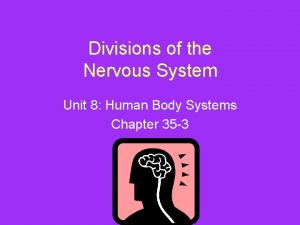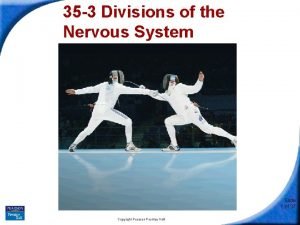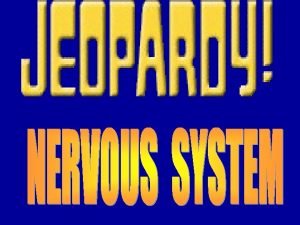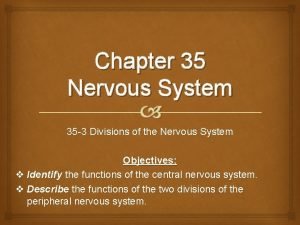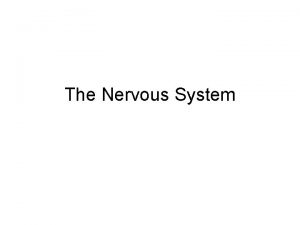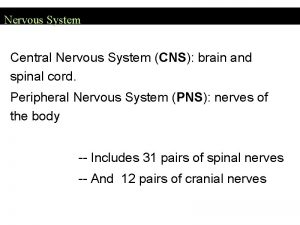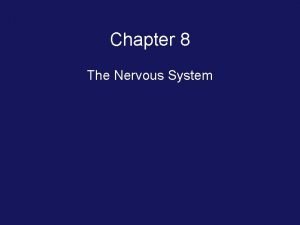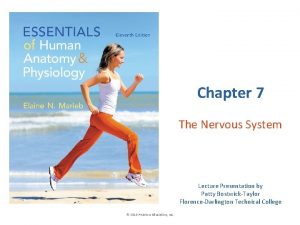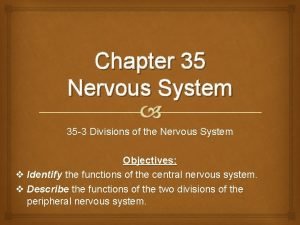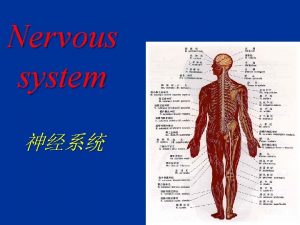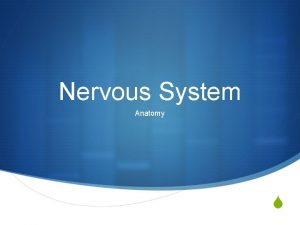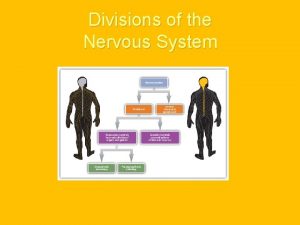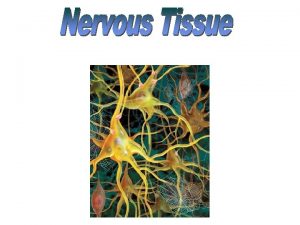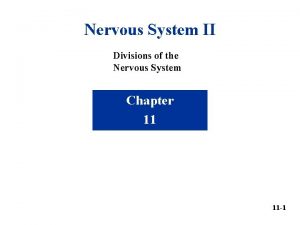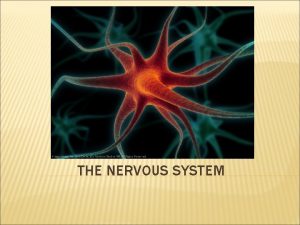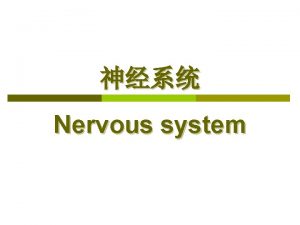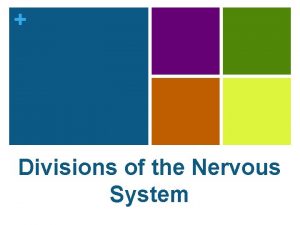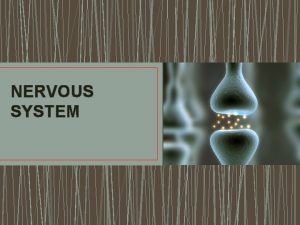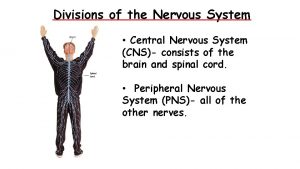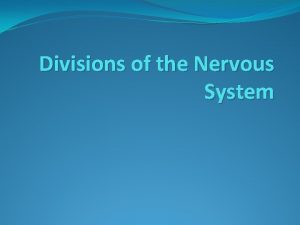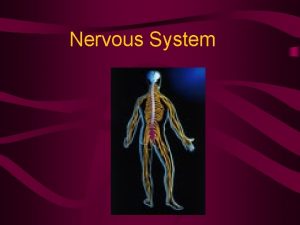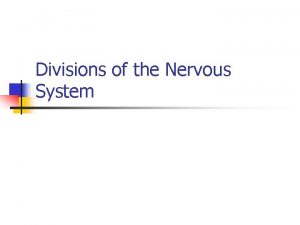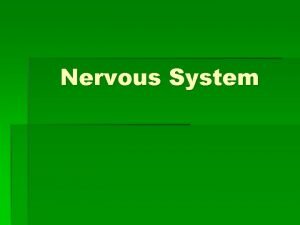Chapter Four Anatomy of the Nervous System Divisions





















- Slides: 21

Chapter Four Anatomy of the Nervous System

Divisions of the Vertebrate Nervous System Central Nervous System-the brain and the spinal cord Peripheral Nervous System-the nerves outside the brain and spinal cord Two Division of the PNS Somatic Nervous System-the nerves that convey messages from the sense organs to the CNS and from the CNS to the muscles and glands Autonomic Nervous System-a set of neurons that control the heart, the intestines, and other organs

Figure 4. 1 The human nervous system Both the central nervous system and the peripheral nervous system have major subdivisions. The closeup of the brain shows the right hemisphere as seen from the midline.


The Nervous System The Spinal Cord-part of the CNS found within the spinal column The spinal cord communicates with the sense organs and muscles below the level of the head Bell-Magendie Law-the entering dorsal roots carry sensory information and the exiting ventral roots carry motor information to the muscles and glands Dorsal Root Ganglia-clusters of neurons outside the spinal cord

Figure 4. 3 Diagram of a cross section through the spinal cord The dorsal root on each side conveys sensory information to the spinal cord; the ventral root conveys motor commands to the muscles.

Autonomic Nervous System Sympathetic-prepares the Parasympathetic-facilitates vegetative, nonemergency responses by the body for arousal body’s organs Ex: increased Ex: increase digestive activity, breathing, increased activities opposing heart rate, decreased sympathetic system digestive activity Consists of cranial nerves and Form chain of ganglia nerves from sacral spinal cord just outside spinal cord Long preganglionic axons extend from the spinal cord to Short preganglionic parasympathetic ganglia close axons release to each internal organ; norepinephrine release norepinephrine Long postganglionic Shorter postganglionic fibers axons release then extend from the norepinephrine parasympathetic ganglia in the organs; release acetylcholine

The Brain The Hindbrain/rhombencephalon Posterior part of brain Medulla-controls vital reflexes like breathing, heart beat, etc Pons-Area where many axons cross from one side of the brain to the other Reticular formation-control motor areas of the spinal cord and sends output to cerebral cortex increasing arousal and attention Raphe system-sends axons to much of the forebrain, increasing or decreasing the brain’s readiness to respond to stimuli Cerebellum-control movement, shifts of attention, balance and coordination

The Brain The Midbrain-middle of the brain Tegmentum-”roof or covering” Nuclei for third and fourth cranial nerves Parts of Reticular formation Extensions of the pathways between the forebrain and the spinal cord or hindbrain Tectum-”roof” Superior Colliculus & Inferior Colliculus-important in routes of sensory information

Figure 4. 8 The human brain stem This composite structure extends from the top of the spinal cord into the center of the forebrain. The pons, pineal gland, and colliculi are ordinarily surrounded by the cerebral cortex.

The Brain The Forebrain-most anterior and most prominent part of the mammalian brain Thalamus Part of the Diencephalon Center of forebrain Relay Station for Sensory Information Hypothalamus Part of Diencephalon Regulates homeostasis, sexual behavior, fighting, feeding Pituitary Gland Endocrine gland attached to the base of the hypothalamus

Figure 4. 10 The limbic system is a set of subcortical structures that form a border (or limbus) around the brain stem

Figure 4. 12 A sagittal section through the human brain

The Brain Forebrain Cont’d Basal Ganglia Responsible for motor behavior, some memory and emotional expression Basal Forebrain Located on the dorsal surface of the forebrain Received input from the hypothalamus and basal ganglia Send axons to cerebral cortex Important in arousal, wakefulness, and attention Hippocampus Located between thalamus and cerebral cortex Critical for the formation of new memory

Figure 4. 14 The basal ganglia The thalamus is in the center, the basal ganglia are lateral to it, and the cerebral cortex is on the outside.

The Brain The Ventricles-Assists in cushioning the brain Central Canal-fluid-filled channel in the center of the spinal cord Ventricles-four fluid-filled cavities within the brain CSF-clear fluid similar to blood plasma Formed in choroid plexus Flows from lateral to third to fourth ventricle to central canal or between meninges Meninges-membranes that surround the brain and spinal cord

Figure 4. 16 The cerebral ventricles Diagram showing positions of the four ventricles.

The Cerebral Cortex Organization of the Cerebral Cortex Contains six distinct layers of cells Organized into columns-cells with similar properties; arranged perpendicular to the laminae Cells within a given column have similar or related properties

The Lobes The Occipital Lobe-posterior end of cortex Contains primary visual cortex The Parietal Lobe-between occipital love the central sulcus Contains the primary somatosensory cortex-receiving touch sensation, muscle-stretch information and joint position information The Temporal Lobe-lateral portion of each hemisphere, near the temples Contains targets for audition, essential for understanding spoken language, complex visual processes, emotional and motivational behaviors The Frontal Lobe-extends from the central sulcus to the anterior limit of the brain Contains Primary Motor Cortex-fine movements Contributes to shifting attention, planning of action, delayed response tasks as examples

Figure 4. 20 Some major subdivisions of the human cerebral cortex The four lobes: occipital, parietal, temporal, and frontal.

Brain Function How Do the Pieces Work Together? Does the Brain Operate as a Whole or a Collection of Parts? Each brain area has a function but it can’t do much by itself The Binding Problem The question of how the visual, auditory, and other areas of your brain influence on another to produce a combined perception of the single object Synchronized neural activity?
 8 divisions of the nervous system
8 divisions of the nervous system Section 35-3 divisions of the nervous system
Section 35-3 divisions of the nervous system Divisions of the nervous system
Divisions of the nervous system 35-3 divisions of the nervous system
35-3 divisions of the nervous system Nervous system divisions
Nervous system divisions Central and peripheral nervous system
Central and peripheral nervous system Graphic organizer of nervous system
Graphic organizer of nervous system What does this graph show
What does this graph show Label the parts of the main divisions of the nervous system
Label the parts of the main divisions of the nervous system What are the characteristics of nervous tissue
What are the characteristics of nervous tissue Nervous
Nervous Neuronal pools are collections of
Neuronal pools are collections of Where are loins on a human
Where are loins on a human Nervous system and digestive system
Nervous system and digestive system Endocrine system and nervous system
Endocrine system and nervous system Mechanism of hormone action
Mechanism of hormone action Adh function
Adh function Componentes componentes
Componentes componentes Chapter 15 nervous system diseases and disorders
Chapter 15 nervous system diseases and disorders Chapter 8 the nervous system
Chapter 8 the nervous system Chapter 7 the nervous system figure 7-2
Chapter 7 the nervous system figure 7-2 Chapter 35 nervous system
Chapter 35 nervous system
